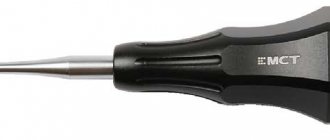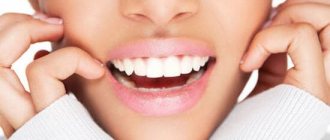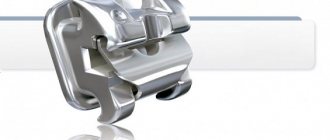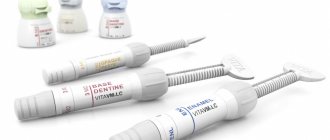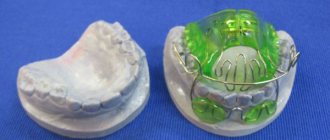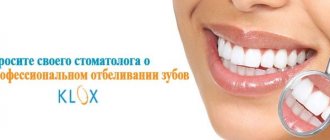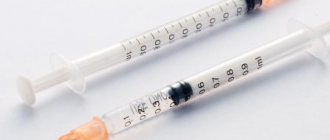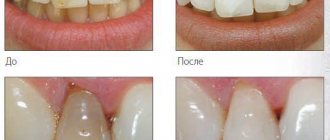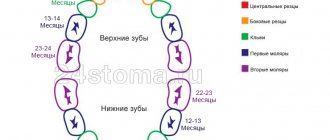3363
In dentistry, there are several types of filling materials, differing in composition, characteristics and release form.
Due to its unique properties, glass ionomer cement is most popular among specialists.
general information
GIC (abbreviated name for glass ionomer cement) is a type of dental material with a heterogeneous (inhomogeneous) structure.
The material was created by Kent and Wilson in 1969 by combining the properties and characteristics of polyacrylic and silicate substances.
Combining the properties of these groups, it has found its use as an insulating liner, raw material for aesthetic restoration, sealing fissures, creating gaskets, filling baby teeth and root canals.
Restoring the integrity of teeth with glass ionomers is gradually replacing cements based on zinc-polycarboxylate and zinc-phosphate.
What is GIC and why is it used in dentistry?
Most patients, when they come to the dental clinic, ask two questions: will it hurt me and how much will the treatment cost? But only a few are interested in the course of treatment: what manipulations the doctor will perform, what materials to use to achieve a high-quality and long-term result. Meanwhile, only in the field of filling materials, modern dentistry has a large line of cementing mixtures, and glass ionomer cement is one of the most progressive. We propose to talk further about this universal material of its kind.
Compound
The constituent components of cement are chemical compounds that determine its basic properties, namely:
- Crushed quartz 40% (silicon dioxide) – adds transparency, slightly lengthens the working time and the hardening period, slows down the hardening process, and slightly reduces the strength of the hardened mass.
- Aluminum phosphate - while worsening transparency, improves mechanical stability, strength, and structural stability.
- Aluminum oxide – increases strength and acid resistance, but reduces the hardening period and working time.
- Barium salts – added for radiopacity.
- Calcium fluoride - introduced to prevent the recurrence of caries.
This extensive combination of components allows glass ionomer cement to be used in many types of dental work.
Characteristics of Spectrum fillings and expert reviews about the material.
Come here to learn more about the types of cement fillings for teeth.
At this address https://www.vash-dentist.ru/lechenie/zubyi/kofferdam-v-stomatologii.html we will talk about the use and types of rubber dam in dentistry.
Detailed characteristics
Glass ionomer cement is a mixture of a filler represented by fluoroaluminosilicate glass and a polymer frame made of polyacrylic, polyitaconic and polymaleic acids.
The liquid may also contain a catalyst system: tartaric acid, camphorquinone (initiates curing under UV rays) and hydroxyethyl methacrylate. The components of the powder in various combinations determine the properties of glass polyalkenate cements:
- quartz (SiO2) adds transparency, reduces the strength of the cured material, and prolongs working time;
- aluminum oxide (Al2O3) reduces the time for working with the material, adds opacity, resistance to acids and strength;
- calcium fluoride (CaF2) adds GIC opacity, strength, and cariesstatic properties;
- aluminum phosphate (AlPO3) increases the opacity, strength of cement and serves as a stabilizer of its structure;
- barium salts and metal impurities are added for radiopacity.
Curing takes place in stages:
- Dissolution (ion formation) is the reaction of polyacids with the surface of filler particles and the formation of Ca2+ and Al3+ ions.
- Hardening (or primary gelation) is the binding of polyacid monomers to each other through Ca2+ and Al3+ ions. Characterized by an increase in pH and the formation of a gel from chains of polymer acids. Duration - 3-6 minutes.
- Final hardening is the formation of stable bonds between aluminum polyalkenoate and fluorine, connecting the longitudinal chains of the polymer with cross-links. Lasts up to a day (24 hours).
An important property of GIC is its ability to chemically adhere to tooth tissue. This is possible due to the establishment of chelate bonds between the carboxyl groups of the polymer (-COO-) and Calcium ions (Ca2+), which are part of the enamel hydrocyapatite and calcium salts of dentin (CaCO3, CaF2, Ca2(PO4)3).
GIC is also capable of forming bonds with stainless steel, gold and platinum alloys, composite materials, and materials containing Eugenol. The adhesion force of GIC is 2-7 MPa. Speaking about the adhesion force, it should be understood that it is not sufficient to withstand the chewing load in full, but it ensures a good marginal fit of the filling.
Classification
GIC is classified according to several criteria:
- According to the release form.
- According to the chemical composition.
- By area of application.
According to the form of release, the material is classified into the following types:
- Powder-liquid . The composition is traditional - the powder part is represented by finely dispersed aluminofluorosilicate cement with various additives, and the liquid is a water-based carbon copolymer containing tartaric acid.
- Pasty mass in tubes . During operation, mixing is avoided; it hardens when illuminated with a halogen lamp.
- Aquacement . The main component is present in the powder. The powder part is mixed only with distilled water.
- Capsules. In them, the liquid and powder part are packaged in the required ratio. Each capsule contains the required volume of material for one-time use, which eliminates errors and inaccuracy of dosage when preparing the mixture.
According to the chemical composition, GIC is divided into two groups:
- Classic .
This includes powder cement and aqua cement, the main components of which are phosphate and aluminum oxide, strontium, silicon dioxide, fluorides, zinc, and barium salts. In the case of aqua powder, crystals of one of the polycarboxylic acids are added to the composition. The liquid is distilled water or an aqueous solution of polycarboxylic acid. - Hybrid. This is a modified polymer variety. The composition of the powder part is similar to the classical group.
The liquid part is represented by a solution of acids of the polycarboxylic group, the molecules of which are modified by the addition of a methacrylate unsaturated group.Hydroxyethyl methacrylate, camphoroquinone, and tartaric acid were also added. Hardening takes place in 2-3 stages.
The last category includes two subtypes of cement:
- Aesthetic .
The composition has increased the content of silicon oxide, which improves aesthetic characteristics. Strength is reduced, the hardening period is increased and susceptibility to moisture is increased. It is used for the restoration of cervical defects located in the frontal part of incisors and canines, as well as for their caries, closing cavities of 1-2 cells. - Hardened. There are metal additives and special fiber structures.
It is slightly inferior in aesthetic indicators to type 1, but has increased strength, resistance to moisture and accelerated hardening. Etching with acids is acceptable, but only if the thickness of the cement layer is at least 0.1 cm. It is used for caries of milk teeth (if the cavities are 1-2 cells) and molars, for temporary fillings (if they are worn for a long time) and sealing fissures, ART- methodology.
The above classification is temporary and conditional, since new GICs are constantly appearing with a modified composition that improves characteristics, properties and expands the scope of use.
Types of glass polyalkinates
Dentistry is one of the most dynamically developing branches of medicine, in which new materials are constantly being created based on various components. This process is reflected in the variety of types of glass ionomer cement.
Classic glass ionomer. It is produced in powder form and contains tiny particles of aluminofluorosilicate glass, silicon dioxide, aluminum oxide and calcium phosphates (which allows for the prevention of caries), as well as zinc and barium or strontium salts for X-ray contrast.
Hybrid glass ionomer. Has several stages of curing. It is produced in powder form, but unlike the classic one, it is mixed not with water, but with an aqueous solution of a copolymer of acrylic or maleic acid, as well as tartaric acid. Such cement is used in the installation of light-curing fillings: first, that part of the material that is hit by the beam of a photopolymerizing lamp hardens, and those areas where light does not penetrate harden according to the classical scheme.
Modified glass ionomer. The fastest growing group of GICs, in which more and more new materials appear every year with the addition of various polymer resins or chemically treated dust-like glass particles. Depending on the composition, such cements are used for various purposes - from sealing fissures to attaching orthopedic structures.
This is interesting! GICs have several forms of release for certain tasks. This is a powder form, when all the components are already in powder, the doctor only needs to dilute them in distilled water; paste form in a tube or syringe that does not require additional manipulation; “powder/liquid” form – polycarbonate acid acts as a liquid. There is also a capsule form, where the powder and liquid are in one capsule, separated by a partition that collapses when shaken. This shape ensures optimal uniform mixing of the components.
Purpose
The scope of application of glass ionomer cements is extensive. Based on this, it is conditionally divided into 3 types:
- Lutingovy (fixing). Suitable for fastening onlays, inlays, bridge-type prostheses, crowns, orthodontic structures.
The main requirement for fixing GIC is the ability to form a thin (no more than 11-13 microns) film between the crown and the tooth surface.Signs of this type are reduced particle size, long working time, liquid-powder ratio 1:1.5.
- Restoration. Designed to restore various defects of the dental surface. It has increased strength, resistance to dissolution due to changes in its composition, and a changed liquid-powder ratio of 1:3. Approximate curing time 5 minutes.
- Interlining .
Placed under composite or amalgam. Characteristics: short operating time, radiopaque, fast hardening period, powder-liquid proportion based on the required strength, ranges from 1.5:1 to 4:1. Curing period: 5 minutes, no etching. When such manipulation is allowed by the manufacturer, the thickness of the cement layer should not exceed 1 mm.
Important! Glass ionomers cannot be used for oral breathing or to restore a volumetric cavity. This will lead to drying out of the cement (in the first case) or to the development of inflammation in the pulp (in the other case).
The course of the hardening reaction
Ion formation , dissolution stage. The acid reacts with the upper glass particles, forming calcium, fluorine, aluminum and sodium cations;
Primary gelation , hardening - polyacid molecules quickly cross-link with each other and with aluminum and calcium ions. At this stage, the pH of the cement increases markedly, and the polyacid molecules turn into a gel;
Final hardening - strong ionic cross-links are formed, mainly from fluorine and aluminum polyalkenate. This stage lasts about a day. It also completely stops the formation of silica gel on glass particles.
Due to the fact that aluminum is a trivalent element, a very high degree of cross-linking is ensured, which ultimately makes the cement extremely strong.
When cement hardens completely, it is structurally composed of glass particles surrounded by silica gel. All particles are located in a matrix created from cross-linked polyacid molecules, along with insoluble phosphate and fluorine salts.
Advantages
The main advantage of the material is its high degree of adhesion to dental tissues. This property is achieved by combining calcium found in the tooth surface with the carboxyl group of polymer molecules.
Also, at the final stage of hardening, an increase in the volume of cement is observed, which ensures its good marginal fit.
Other advantages of the GIC include the following characteristics:
- Chemical compatibility and good adhesion to composites , metals, and materials containing eugenol.
- The presence of bacteriostatic and cariesostatic effect. Their manifestation is based on the release of fluorides during and upon completion of glass ionomer hardening, as well as the formation of a fluorapatite layer (the effect lasts up to a year).
- The presence of a “battery” effect , i.e. ability to adsorb fluoride ions from pastes and remove them into surrounding tissues.
- Biological compatibility , the material is non-toxic, which makes it possible to use it for insulating gaskets.
- The thermal expansion index is close to that of dentin tissues and enamel. This property prevents cracking of the cement and disruption of its adherence when the temperature in the mouth fluctuates.
- Low coefficient of elasticity - allows filling large (5 cells) cavities.
- Sufficient compressive strength , which makes it possible to use GIC as a base for a composite when performing “sandwich” fillings.
- The minimum shrinkage during polymerization is no more than 3.5%. This figure is 45% less than that of photocomposites.
- Convenient and easy to work with. The use of most of them does not involve preliminary etching or bonding (application of polymer) of the enamel.
- It hardens in humidity , which makes it possible to fill a wedge-shaped defect or cervical cavities.
- Low cost.
Let’s calculate together how much it costs to put a filling on a front tooth, and discuss the factors that influence the price.
In this publication we will tell you what to do if a filling unexpectedly falls out.
Here https://www.vash-dentist.ru/lechenie/zubyi/plombyi/svetovyie-na-perednih-osobennosti-plyusyi-i-minusyi-stoimost.html we will find out how much a light filling for a front tooth costs.
Glass ionomer cements
Glass ionomer cements ( GIC, glass ionomers, polyalkenate, glass polyalkenate cements ) combine low toxicity, high strength and satisfactory aesthetic characteristics, and also exhibit anticaries activity. Recently, the interest of dentists in this group of filling materials has been increasing. GIC can be used when applying both basic and thin-layer (liner) insulating gaskets, permanent fillings, as well as for fixing permanent orthopedic structures, etc.
It should be noted that the name glass polyalkenate cements is more correct and meets the requirements of the international standard (ISO). However, taking into account the terminology established in the domestic literature, in the manual these materials will be called glass ionomer cements (GIC). The range of glass ionomer cements currently produced allows us to successfully solve most problems in practical dentistry, taking into account not only the properties of the materials, but also the individual preferences of the doctor, the financial capabilities of the patient, and the material and personnel equipment of the medical institution.
“Classical” glass ionomer cement is a “powder/liquid” system. Powder - calcium aluminosilicate glass with the addition of fluorides (up to 23%). The liquid is a solution of polycarboxylic acids: polyacrylic, polyitaconic and polymaleic. During the curing process of cement, cross-linking of polymer acid molecules occurs with aluminum and calcium ions extracted from the glass. In this case, a three-dimensional spatial structure of the polymer is formed, and a shell of silica gel is formed on the surface of unreacted glass particles (during the curing process, a chemical transformation of 20-30% of the glass occurs) (see Fig. 189). Thus, the final structure of hardened cement is glass particles surrounded by silica gel, and located in a polymer matrix of cross-linked polycarboxylic acids (see Fig. 190).
The main positive properties of GIC:
1. Chemical adhesion to tooth tissue . The chemical binding of GIC to enamel and dentin occurs due to the chelate connection of the carboxylate groups of the polymeric acid molecule with calcium of the hard tissues of the tooth (Fig. 191). This does not require acid etching and absolute dryness of the surface. At the same time, it should be remembered that the adhesion force of glass ionomer cements to enamel and dentin is relatively low (2-7 MPa). Therefore, the presence of a chemical bond with the hard tissues of the tooth is important not so much for the strength of the connection, but for ensuring impermeability along the line of contact of the filling material with the hard tissues of the tooth (Videnko N.V., 1999). Glass ionomer cements should be preferred for non-carious lesions of hard dental tissues. This is due to the fact that with this pathology, a change in the structure of enamel and dentin occurs, and composite adhesive systems designed for the normal structure of these tissues often turn out to be ineffective.
Important from a practical point of view is the fact that due to chelagic and hydrogen bonds, glass ionomer cements form chemical adhesion with composites, stainless steel, yulot and platinum staves, oxidized foil, as well as materials containing vgenol. In addition, an important advantage of glass ionomer cements is that at the final stage of hardening there is a slight increase in the volume of the cement mass. This ensures a tighter marginal fit of the filling (see Fig. 192).
2. Anti-caries activity is ensured due to the prolonged release of fluoride from the cement mass into the environment. This process begins immediately after filling and continues for at least one year. The diffusion of fluoride into the surrounding tissues causes increased mineralization and the formation of fluoranatites in the enamel and dentin adjacent to the filling. This leads to an increase in acid resistance and a decrease in dentin permeability, a deterioration in the living conditions of pathogenic microorganisms, and the prevention of the development of recurrent caries. It has been established that the bacterial contamination of the surface of GIC is significantly lower than that of fillings made of zinc-phosphate, polycarboxylate cements and composites. The release of fluoride by glass ionomer cements significantly exceeds the release of fluoride by compomers and composites containing fluorine.
The cariesstatic effect of glass ionomer cements has been confirmed by a number of experimental and clinical studies. In addition, it has been established that glass ionomer cements have a so-called battery effect. They are capable of adsorbing fluoride ions upon contact from fluoride-containing toothpastes and elixirs, food products, and exogenous prophylaxis agents (Fig. 193, 194). When the environment surrounding the tooth becomes acidic (“cariogenic situation”), glass ionomers release fluoride into the adjacent tissues. That is why the use of glass ionomer cements is especially indicated in patients with severe dental caries and a “problematic” oral cavity (low level of hygiene, high CP, high frequency of recurrent caries).
3. Sufficient mechanical strength and elasticity. Glass ionomer cements have high compressive strength. In addition, they have a low elastic modulus (Young's modulus), i.e. high elasticity. These properties allow them to withstand occlusal loads under fillings, inlays and crowns. To some extent, glass ionomers are able to compensate for the polymerization shrinkage of composites, as well as the stresses that arise in the cervical area during microbending of the tooth during chewing. In addition, the coefficient of thermal expansion of GIC is close to the coefficient of thermal expansion of tooth tissue (Table 20), which is important for ensuring long-term tightness at the filling/tooth tissue interface.
4. Satisfactory aesthetic properties make glass ionomer cements the material of choice in those clinical situations where the use of a composite is impossible for some reason.
5. High biological compatibility , non-toxic and non-irritating to the dental pulp. Experimental studies have found that GICs have a milder effect on the dental pulp than zinc oxide eugenol and zinc phosphate cements. One of the most likely reasons for this is the high molecular weight of polyacrylic acid: due to its large size, the molecule cannot diffuse through dentin and cause irritation. The high biocompatibility of GIC allows them to be used without insulating pads or as a cushioning material in the treatment of medium caries; however, for deep caries it is necessary to use a therapeutic pad based on calcium hydroxide (Bidenko N.V., 1999).
6. Easy to use. This factor is important in the treatment of children, in gerontodental practice, as well as in other situations when the patient is physically unable to sit still with his mouth open for a long time necessary to fulfill all the requirements of the “composite technology”. In addition, the ease of applying a glass ionomer filling makes this material indispensable in the treatment of caries and sealing dental fissures in conditions that preclude the use of composites, compomers and polymer fissure sealants: in school dental offices, in remote rural areas, on field sanitation work in the treatment of dental caries using the ART technique.
7. Relatively low cost (compared to composites). The low price with a completely satisfactory quality of fillings makes glass ionomer cements the main materials when providing “free” dental care to low-income segments of the population, when applying fillings to teeth with a questionable prognosis (for example, in severe periodontitis), when filling baby teeth, etc. At the same time, it must be emphasized that “classical” glass ionomer cements have a number of disadvantages that limit their clinical use to a certain scope and require the doctor to fulfill a number of conditions and techniques.
The disadvantages of “classical” glass ionomers are:
1. Duration of “maturation” of the cement mass. Despite the fact that the initial hardening of the material occurs within 3-6 minutes, the final “maturation” of the cement mass lasts for 24 hours. Only after 24 hours the material becomes insensitive to external influences. Therefore, in the first day after application, “classical” glass ionomer cement has a number of “weak points” (Table 21).
A. Sensitivity to excess or lack of moisture during curing. Excess moisture during the hardening process of the cement mass leads to the leaching of aluminum ions and disruption of the formation of the three-dimensional spatial structure of the polymer. Overdrying of hardening cement leads to disruption of the dissociation process of the polymer acid and reduces the release of metal ions from glass particles, as a result of which the chemical reaction of cement hardening is also disrupted. In both cases, the physical, mechanical and chemical properties of the material deteriorate. Therefore, it is recommended to coat a glass ionomer cement filling with an insulating varnish immediately after application. Protection from moisture must last for at least one hour. This is the amount of time required to reach sufficient ion levels for the cement to cure optimally. B. Sensitivity to external mechanical influences during the “maturation” process. It has been established that mechanical influences, especially vibration during processing with burs and abrasive tools, can disrupt the formation of a chemical bond between cement and tooth structures. This leads to a violation of the tightness at the filling/tooth interface, the appearance of micro-leakages and, as a consequence, an unsatisfactory filling result. Therefore, after applying a filling made of “classical” glass ionomer cement, it is recommended to cut off the excess material with a sharp scalpel, cover the filling with an insulating varnish, and carry out the final grinding and polishing at the next visit, no earlier than 24 hours later. B. Sensitivity to mechanical stress and vibration during the “ripening” of the cement mass is expressed in the fact that if an “immature” glass ionomer filling is treated with rotating tools (burs, abrasive or polishing heads), then due to microvibrations that inevitably arise during the operation of the tip , the chemical bonds of the glass ionomer gel matrix with the hard tissues of the tooth are disrupted.
As a result of this chemical connection of the filling with the tooth tissues does not occur, the adhesion and marginal fit of the filling worsens, and the dentist does not receive the clinical result that he expected. In this regard, it is recommended to carry out the initial processing of a “classic” glass ionomer filling (removal of excess, correction of bite height) using hand tools: scalpels, carvers (pointed trowel), excavators. Grinding and polishing of the filling using rotary abrasive instruments should be carried out at the next visit. It must be emphasized that some modern “classical” glass iopomers, due to improved production technology, are less sensitive to external influences during the “maturation” of the cement mass. For example, a filling made from “Ketac Molar” (ZM ESPE) or “lonofil Molar” (VOCO) can be treated with burs and abrasive instruments within 5-7 minutes after application. Although, in our opinion, it is better to do this after 24 hours. D. The likelihood of disruption of the chemical composition and curing process when etching the “unripened” cement mass with phosphoric acid. Phosphoric acid is known to be a more active chemical reagent compared to the polymeric acids used in glass ionomer cements. Therefore, when acid etching the surface of “unripened” GIC, there is a great danger of displacing the polymer acid from the reaction, which will inevitably lead to disruption of the GIC curing process and a change in its properties. D. Danger of irritation to the pulp in deep cavities. It has been established that freshly mixed GIC, when applied to the bottom of a deep carious cavity, can cause osmotic injury to odontoblasts, the appearance of increased sensitivity, and sometimes even pulp necrosis. Therefore, as noted above, when filling deep carious cavities, the use of a therapeutic pad based on calcium hydroxide is necessary.
2. Lower strength characteristics than composite materials. Glass ionomers are especially significantly inferior to composites in such parameters as diametric tensile strength, fracture strength, and abrasion resistance. In this regard, it is not advisable to use GIC in cavities where the material experiences significant multidirectional loads: when restoring the incisal edge or cusp of a tooth, when filling with parapulpal pins. Filling with glass ionomer cement is justified if the filling is surrounded on all sides by a sufficiently thick layer of hard tooth tissue. At the same time, Black class I cavities in permanent teeth should not be filled with glass ionomer cements, since the filling in them is subject to increased abrasive wear.
3. Insufficient aesthetics. In terms of aesthetic characteristics, glass ionomer cements are significantly inferior to modern composite materials. The main disadvantages of glass ionomers as materials for aesthetic tooth restoration: high opacity (opacity) and insufficient polishability. Therefore, at present, these cements in aesthetic dentistry are used only as an auxiliary material, for example, to mask color spots, metal pins, etc. The exception is those cases when the use of a composite is impossible for some reason.
However, you should not expect excellent aesthetic results when using glass ionomer alone. Currently, the process of modernization of glass ionomer cements continues. One of the main directions of research in this area is improving the curing mechanism of GIC, aimed at improving the handling properties, physicochemical and aesthetic characteristics of materials of this group. Over thirty years of development, which continues to this day, several groups of glass ionomer cements have been created (Table 22). In aqua cements (i.e. mixed with water), the powder contains aluminosilicate glass and lyophilized polyacrylic acid, the liquid is distilled water. When the powder is mixed with water, the polyacrylic acid dissolves and the cement hardening reaction begins. The use of aqua cements makes it possible to ensure an optimal glass-acid ratio and facilitates mixing. At the same time, the powders of these cements actively absorb water vapor from the air, thereby changing their original properties. Therefore, the powder should be kept tightly sealed and placed on a mixing block immediately before use. Usually, in order to avoid unwanted hydration of cement powder, manufacturing companies place a capsule with a desiccant (silica gel) in the bottle. In addition, aqua cements have all the same disadvantages as “classical” GICs.
“Classical” GIC and glass ionomer cements mixed with water are called true glass ionomer cements. A fundamentally new direction in improving GICs was the inclusion of a light-curing polymer resin in their composition. The chemical composition of these cements ensures the formation of strong bonds between the polymer and glass ionomer matrices, which makes it possible to obtain a strong, homogeneous cement mass. Such materials are commonly referred to as hybrid glass ionomer cements , resin cements, or polymer modified glass ionomers. The first representatives of this group of materials were dual-curing hybrid glass ionomer cements. As the name suggests, they have two curing mechanisms:
1. Under the influence of light from an activating lamp, a rapid “composite” reaction of curing the polymer matrix occurs; as a result, a dense polymer frame is created, which ensures the strength and stability of the material at the initial stage of hardening.
2. Immediately after mixing the powder and liquid, the slow chemical curing reaction typical of glass ionomers begins, lasting about 24 hours. In this case, the glass ionomer matrix is combined with the polymer one. Hybrid glass ionomer cements are less sensitive to moisture and dehydration, have improved strength characteristics, harden without the formation of microcracks, and have increased adhesion force to tooth tissues. Please note that the polymer matrix of dual-curing hybrid glass ionomers hardens only under the influence of light from an activating lamp. Therefore, these materials are not suitable for fixing crowns, caps, intracanal pins, etc. In addition, to ensure complete photopolymerization of all areas of the filling, dual-curing hybrid glass ionomer cements should be applied and cured in layers no more than 2 mm thick. To overcome these disadvantages, a triple-curing hybrid glass ionomer cement, Vitremer, was created.
This material has three curing mechanisms:
- light curing of the polymer matrix - immediate curing under light irradiation makes it possible to achieve high strength already during operation, provides ease of use, and reduces the possibility of contamination;
- chemical curing of the polymer matrix is ensured by the powder containing microcapsules with a patented catalytic system. When mixing cement, the capsules are destroyed and the catalyst is activated. The possibility of chemical polymerization of the material without light irradiation guarantees optimal curing of all areas of the filling. Thus, there is no need for layer-by-layer application of material. Simultaneous application of a filling, even of a large volume, makes it possible to obtain a uniform structure and significantly saves time;
- The glass ionomer curing reaction, which lasts for 24 hours inside a durable polymer “frame,” provides chemical adhesion, biocompatibility, and prolonged release of fur, and, consequently, high quality restoration and a reduced likelihood of developing recurrent caries.
The use of a triple-curing mechanism made it possible to significantly increase the strength of Vitremer, reduce its polymer shrinkage, and expand its indications for use. To date, Vitremer remains the only glass ionomer cement . So-called one-component light-curing GICs have a polymer matrix that hardens under the influence of light and a glass ionomer filler. However, when they are cured, only the photopolymerization reaction of the polymer occurs; no hecloiopomer reaction occurs in them! In this regard, it is hardly correct to classify these materials as glass ionomer cements. Rather, they are light-curing polymer materials with glass ionomer filler. Classification of modern glass ionomer cements. Currently, the most common and generally accepted classification of glass ionomer cements is based on the classification of J. McLean (1988):
Type I - GIC for fixation.
Type II - Restorative GIC for permanent fillings:
a) aesthetic;
b) strengthened;
c) condensable.
Type III - Fast-hardening GIC:
a) for gaskets;
b) fissure sealants.
Type IV - GIC for filling root canals.
In general, if we talk about indications for the clinical use of glass ionomer cements, the following should be highlighted:
- fixation of orthopedic and orthodontic structures, intracanal pins and stump inlays;
- application of base and liner gaskets under composite and metal fillings;
- fissure sealing;
- filling carious cavities in primary and permanent teeth, including root caries;
- filling of hard tissue defects in case of peccary lesions of teeth;
- ART-method and minimal preparation in the treatment of dental caries;
- filling cavities with minimally invasive therapy for caries treatment;
- restoration of the tooth stump.
It should be noted that glass ionomer cements intended for different purposes have different properties and handling characteristics. GIC intended for fixation has a liquid consistency and increased fluidity. In addition, they are characterized by extended working and curing times. Such properties are necessary for the doctor’s careful technological work when fixing crowns and other non-removable orthopedic structures. Glass ionomer cements, intended for permanent fillings, have a thick, dense consistency due to their higher powder content. They are characterized by extended working hours and shortened curing times. The listed properties give the cements of this group increased mechanical strength and make the filling process more convenient and technological, allowing the doctor to simulate a filling in the oral cavity. Glass ionomer cements for linings have a liquid consistency, which provides good marginal adaptation, but leads, however, to a decrease in their mechanical strength. In addition, materials in this group are characterized by reduced working time and curing time. This property allows the doctor, after applying the glass ionomer gasket, to quickly move on to the next stage of filling.
Glass ionomer cements for filling root canals have a longer curing time (1.5-3 hours), higher radiopacity, increased biocompatibility and stability. It should also be noted that attempting to change the consistency of cement by changing the powder/liquid ratio ultimately leads to a deterioration in its physical characteristics. In connection with the above, we avoid the use of “universal” glass ionomer cements. In our work, in each clinical situation, we strive to use the glass ionomer that is specifically designed for this purpose (for liners - cushioning, for fillings and base gaskets - restorative, etc.). As noted above, the use of glass ionomer cements for filling carious cavities is especially indicated in patients with a “problematic” oral cavity and severe dental caries (low level of hygiene, high rate of dental caries, high frequency of recurrent caries). The Russian market offers a large number of glass ionomer cements for applying insulating gaskets, both chemical and dual-curing (see Table 23). “Classical” GIC for insulating linings have sufficient mechanical strength, chemical adhesion to enamel and dentin, release fluoride ions into the surrounding dental tissues, and do not require light curing. The average curing time for cements of this type is 3-5 minutes. One of the materials of this group that is popular in our country is BaseLine (StomaDent). It allows you to achieve protection of the pulp and hard tissues of the tooth from chemical, thermal, galvanic irritants and bacterial invasion. The high adhesion of BaseLine is combined with strength, radiopacity and satisfactory performance. "BaseLine" is available in shade B2. It is close in color to tooth dentin. Mixed with distilled water.
The use of this material is indicated when applying base and liner insulating gaskets. It can also be used for fixation of crowns and post structures (although special GICs are more acceptable for these purposes). A wide range of glass ionomer cements for the application of insulating base and liner gaskets is supplied to the Russian dental market by VOCO, which allows the doctor to make the optimal choice taking into account the characteristics of the clinical situation, further treatment plan and individual preferences. It should be recalled that the “ripening” of the cement mass of “classical” and water-curing GIC and the formation of a strong bond with the dental tissues occurs within approximately 24 hours. Therefore, when filling using the sandwich technique, if “classical” GIC is used as a base lining, and the composite is applied during the same visit, due to the rapid and strong binding of the composite to the glass ionomer, as well as due to the polymerization shrinkage of the composite, the likelihood of separation of the gasket from the bottom of the cavity (Fig. 195). Clinical manifestations of debonding are pain in the tooth from temperature stimuli, pain when biting on a filling, and sometimes inflammation and necrosis of the pulp.
Most foreign and domestic dental schools recommend filling with composites in combination with “classical” or water-curing GIC in two visits:
I visit - the entire cavity is filled with glass ionomer cement;
II visit - after 24-48 hours - a part of the glass ionomer filling corresponding to the enamel is removed and filled with a composite with preliminary etching of the GIC surface and the use of an adhesive system.
This technique is undoubtedly justified from both medical and physicochemical points of view. However, in our country, due to economic, organizational and psychological factors, it has not yet become widespread. Apparently, the lack of awareness among dentists also plays a role.
A modified sandwich technique or the use of dual- and triple-curing hybrid GICs can be used to apply a glass ionomer cement lining and a composite filling in one visit. The most famous and popular dual-curing hybrid glass ionomer in our country is “Vitrebond” (ZM ESPE). It is a two-component powder/liquid system. The powder consists of fluoroaluminosilicate glass; the liquid contains polycarboxylic acid, water, polymerizable mono- and oligomers, as well as photoinitiators of the polymerization process. After mixing the ingredients, Vitrebond has a fairly long “working” time and quickly hardens under the influence of light (irradiation time - 30 seconds). This curing dynamics distinguishes Vitrebond from “classical” glass ionomers (Fig. 196). The material is easily introduced into the cavity and has good adaptation to the hard tissues of the tooth.
A permanent filling can be placed on a Vitrebond lining during the same visit. This is due to the fact that due to the presence of a light-curing polymer matrix, immediately after photopolymerization the material becomes quite strong and chemically inert. It is resistant to chemical and mechanical influences, does not crack when the cavity dries, forms a strong bond with dentin and is able to compensate for the stresses arising during the polymerization shrinkage of composites.
We widely use Vitrebond for applying insulating pads in the treatment of deep caries. The need to use an insulating pad in this case is dictated by the fact that calcium salicylate cements, most often used as therapeutic pads (Dycal, Life, Septocalcine Ultra), are dissolved and destroyed by the components of modern adhesive systems (acetone, alcohol and etc.). In addition, therapeutic lining materials have very low compressive strength and when the filling is localized on the occlusal surface, they can be destroyed (Fig. 197). As a result, voids form under the filling, and this can lead to various adverse consequences, including the development of inflammation and necrosis of the pulp. When filling deep carious cavities, we are guided by the recommendations of A.V. Sadova (1997): “When treating deep caries, cushioning materials based on calcium hydroxide should be introduced into the cavity pointwise, in a minimum amount, with the obligatory application of an insulating pad” (see Fig. 198) .
To summarize this section, the authors want to once again focus the readers’ attention on the indications for the use of Vitrebond in a clinical setting:
- (thin-layer) lining for moderate caries in a patient with a “problematic” oral cavity, when the doctor considers it advisable to take additional measures to prevent recurrence of caries under the filling;
- applying a liner under a composite filling in a carious cavity of complex configuration (high C-factor value), when the doctor considers it advisable to take additional measures to compensate for the stresses that arise during the polymerization shrinkage of the light-curing composite and to prevent “postoperative sensitivity”;
- application of an insulating lining for deep caries to prevent destruction of the therapeutic lining material by the components of the composite adhesive system and occlusal loads;
- applying a liner under a composite filling if the doctor plans to complete the tooth treatment in one visit.
Did you like the article? Share with friends
0
Similar articles
Next articles
- Chronic periodontitis
- Structure and functions of dental pulp
- Etiology of pulpitis
- Pathogenesis of pulpitis
- Classification of pulpitis
Previous articles
- Finishing, grinding and polishing of a metal-plastic crown
- Metal-plastic crowns on a cast base
- Metal-plastic crowns on a stamped base
- Metal-plastic crowns
- Application and fixation of a plastic crown
Add a comment
Flaws
Glass ionomers have the following disadvantages:
- Long "maturation" . Primary hardening takes 5-7 minutes, final hardening takes up to 24 hours.
- The first 24 hours after filling are sensitive to a deficiency or excess of moisture , which is why in the first case the structure is disrupted, and in the second case ions are washed out. To prevent these phenomena, the filling is coated with protective dental varnish.
- There is sensitivity to mechanical stress , so grinding and polishing of the filling is carried out at the second visit.
- GIC cannot be etched with orthophosphoric acid , since this procedure disrupts the ripening process.
- Insufficient diametric tensile strength , which does not allow the material to be used in areas experiencing increased multidirectional loads.
- Low abrasion resistance , making it impossible to seal cavities that experience high loads.
- In terms of aesthetic indicators, it is slightly inferior to the composite. Problems include high transparency and difficulty in polishing.
- Cannot be used for sealing deep cavities , because... GIC adsorbs fluids from pulpal odontoblasts.
Currently, the process of improving glass ionomers and eliminating their shortcomings continues.
Recommendations
Experienced experts recommend adhering to the following rules:
- For high-quality application of cement and its further hardening, it is necessary to ensure optimal moisture in the dental tissue. It is important not to dry it out, but also not to leave it too wet.
- When mixing the material, you should act quickly so that the cement mass does not lose its shine and elasticity, as this indicates its further unsuitability.
- When applying glass polyalkenate cement under amalgam, its thickness should not be less than 1 mm.
- A tooth restored with cement paste should be coated with an insulating varnish to prevent moisture absorption.
- Modeling of the filling can be carried out only after its final hardening. This avoids dehydration and weakening of the material.
- It must be taken into account that 2-3 weeks after the installation of a glass ionomer filling, the material tends to darken, so initially you should use a material 1-2 shades lighter than required.
What light fillings look like on the front teeth, their pros and cons.
In this article we will tell you why pain occurs after cleaning the tooth canals.
Here https://zubovv.ru/lechenie/zubyi/kakim-obrazom-reagiruet-na-holodnoe-i-goryachee.html find out why a tooth reacts to heat after filling.
Mode of application
The principle of working with cement depends on its type and method of hardening. So, the use of this material with a classic composition or aqua cement takes place in the following sequence:
- The oral cavity is treated with conditioner.
- In 20 minutes. the mouth is rinsed and dried.
- The problem unit is isolated from moisture.
- Mix the liquid with the powder until a homogeneous mass is obtained (about 30-40 seconds).
- The prepared mass is placed into the tooth cavity.
- The filling is modeled and condensed with a plugger or a moistened cotton swab.
- When finished, it is coated with a protective varnish.
Its grinding and polishing is carried out only on the next visit.
Filling technology using double-curing GIC:
- The enamel is etched with phosphoric acid and dried.
- The tooth is isolated from moisture.
- The adhesive mass is applied and polymerized.
- In accordance with the required proportion, 2 pastes are mixed.
- The cavity is dried and separated from moisture.
- Cement is added in layers until the required filling height is obtained. Each layer is condensed and illuminated by a photopolymerizer.
- The finished filling is processed with burs.
If triple-cured material is used, filling takes place in the following sequence:
- Dental tissues are etched with phosphoric acid, which is then washed off and the cavity is dried.
- The working area is separated from saliva.
- The adhesive mixture is applied.
- The cavity is purged and illuminated.
- Cement is mixed.
- The finished mass is placed in one portion and condensed.
- The filling is ground and then polished.
Important! The dentist warns the patient that for the first 2-3 weeks the color of the filling will be lighter than the natural dental tissues.
When working with glass ionomers, it is important for a specialist to remember several important points:
- When used as a gasket under the amalgam mass, the thickness of the applied layer should be at least 0.1 cm.
- When working with “classics”, it is important to achieve the optimal percentage of fabric moisture.
- An acceptable period for cementing orthopedic products and pins is considered to be when the cement is in the “stretching thread” phase, i.e., when tearing off a spatula produces a stretching thread.
- The hybrid variety requires tissue etching and the use of an adhesive system.
The video presents a technique for using glass ionomer cement for filling.
Useful information
It should be remembered that:
- when using GIC for amalgam, the thickness of the gasket should be at least 1 mm;
- the optimal period for cementing pins and orthopedic structures is the stage of “stretching threads”, when when the spatula is torn off, the cement forms viscous threads (like chewing gum);
- when working with “classic” GIC, it is important that the tissue moisture is optimal; to do this, it is dried until the dentin takes on the appearance of wet sand (“sparkling” dentin);
- hybrid cements require tissue etching and the use of adhesive systems;
- Preparing the cavity for adding “classic” GIC - using a conditioner (solution with monomer) according to the instructions.
Glass ionomer cement is the material of choice when placing fillings in cases of multiple caries, caries of primary teeth and poor oral hygiene, because These materials emit fluoride, which prevents the development of caries.
GRC fillings are not durable or aesthetically pleasing as composite fillings and are not abrasion resistant, so they are not suitable for restoring the occlusal surface or incisal edge of a tooth. But they provide good edge adhesion, almost do not shrink, and are non-toxic.
Also, when installing a glass ionomer filling, you should not worry that the filling may crumble the thin walls of the tooth under the influence of hot food. Therefore, although composites are ahead of GIC in some characteristics, glass polyalkenate cements confidently occupy their niche among materials for luting work, filling temporary teeth, dental caries and isolating liners.
Manufacturers' offers
Dentists use several types of glass ionomer cements. The most popular brands are the following.
Vitremer
The only type of glass ionomer with triple curing. It has good adhesion to dental tissues even at high relative humidity and without etching.
This argument allows it to be used for restoration, restoration of mammary elements, as well as for securing orthopedic structures.
The advantages include the following indicators:
- does not involve layer-by-layer application and preliminary creation of a gasket;
- the degree of solubility is low;
- high coefficients of elasticity and strength;
- prolonged release of fluorides;
- improved aesthetic characteristics;
- easy to use;
- radiopaque.
Fuji IILC
It hardens in the light, is radiopaque, has biocompatibility, stable chemical adhesion, decent appearance and is capable of releasing fluoride.
Applicable:
- filling cavities of classes 3 and 4;
- restoration of milk units;
- fixing the pins.
After application it is sensitive to humidity, so it is recommended to apply a protective varnish over the filling.
Shelon-Phil
This is a polymaleic GIC filling that is bonded to dental tissues by a chemical reaction. Creates a tight seal, is used without a gasket if the cavity is not deep (dentine thickness is less than 1.5 mm - the presence of a gasket is required), releases fluoride ions, nourishing the tissues adjacent to it.
It is used for filling frontal units, cavities from classes 1 to 4, milk elements, wedge-shaped defects, shallow fissures and in modeling a dihedral base.
The filling requires mandatory varnishing, and subsequent processing (grinding and polishing) is carried out after 7-10 minutes. after varnishing.
Ketak-Molar
The material is radiopaque, chemically cured. Used to treat permanent chewing and milk units.
It is characterized by resistance to removal, releases fluorides, and condenses. Working time – 3 minutes, hardening period – no more than 5 minutes.
Available in two versions:
- Applicap. Radiopaque, dosed in capsules, used for filling mammary and permanent elements. Resistant to compression and abrasion, operating time - 2 minutes, hardening time taking into account mixing time - 4 minutes.
- Plus. Chemically hardened cement, radiopaque, suitable for the treatment of permanent frontal and mammary units. Capable of releasing fluorides in the fabric, ensures a secure fit, and is color fast. Working time – 2 minutes, curing time – 7 minutes.
Price
Filling is an expensive dental service. The final cost is influenced by the location of the element being restored and its condition, the complexity of the procedure, the equipment used, the type of filling, the pricing policy of the center, its status and location, and the qualifications of the specialist.
The volume of therapy performed, the type of anesthetic administered, and the number of preparatory procedures are also important.
The average price for filling one tooth with GIC ranges from 1200 rubles. up to 1600 rub.
Reviews
Dentists use several types of filling materials in their work. But of these, the most popular are cement glass ionomer masses.
This is due to a large number of advantages, the main ones being durability and affordability.
You can tell us about your experience of restoring teeth with fillings based on this material and express your opinion about its quality by leaving your comment on this article.
If you find an error, please select a piece of text and press Ctrl+Enter.
Tags treatment of fillings glass ionomer cement
Did you like the article? stay tuned
Previous article
Gutta-percha points – high-quality root filling
Next article
Difficulties in identifying initial pulpitis and treatment tactics
